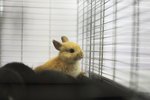
Wild rabbits might look similar to the cuddly domestic creatures you see in homes as pets, but they're a lot more self-sufficient and independent than the latter cuties. From nesting to tracking down sufficient sustenance for themselves each day, wild rabbits know how to live on their own.
Nest Construction
Rabbit mothers are responsible for nest construction. Mothers from the majority of wild rabbit species establish "forms," or nests that don't go too far down in depth and have clear basin shapes. The females use a variety of components to establish these nests, including bits of fur that they extract from their own coats, specifically their stomach areas. They also employ grasses and foliage to complete their nests.
Nesting Locations
When rabbit mothers scout out new locations for nests, they tend to look for conspicuous spots out in the open. Some common sites for rabbit nests are heaps of brush, margins of fields and lawns that provide sufficient cover. Wild rabbit nests are sometimes even located in peoples' yards.
All By Themselves
Rabbit mothers don't spend a lot of time alongside their youngsters in their nests -- a means of staying low-key and preventing potential predators from taking notice. They only stop by their nests twice each day, once at daybreak and then again at twilight. Feeding of the little ones occurs during those times. Because the mothers usually aren't with their offspring at their nests, it often isn't easy to figure out whether or not a litter has maternal care. In most cases, mom is indeed around -- they're just waiting for her. In other cases, the litter might be motherless if she died or, in some instances, abandoned them.
Caring for Baby Bunnies
Since rabbits are altricial creatures, their youngsters aren't born self-sufficient, but rather vulnerable and unable to manage without parental assistance. The kits begin their lives without vision and hearing. Nursing sessions generally last for approximately 5 minutes each day. Youngsters finally depart from their nests when they're around 3 weeks in age. At this point, they can care for themselves and have totally upright ears and ample fur. They also are capable of hopping. Importantly, they have the ability to find food and hide from dangerous predators at this time -- both essential survival skills.
References
- Great Lakes Rabbit Sanctuary: About Wild Rabbits
- People for the Ethical Treatment of Animals: Living in Harmony With Wild Rabbits
- National Geographic: Cottontail Rabbit
- Project Wildlife: Rabbits
- The Humane Society of the United States: What to Do About Wild Rabbits
- Indiana House Rabbit Society: Wild Rabbits
- House Rabbit Network: Wild Baby Rabbits
- Washington Department of Fish & Wildlife: Rabbits
- University of Illinois Extension: Baby Rabbits in My Yard
Photo Credits
-
NA/AbleStock.com/Getty Images




